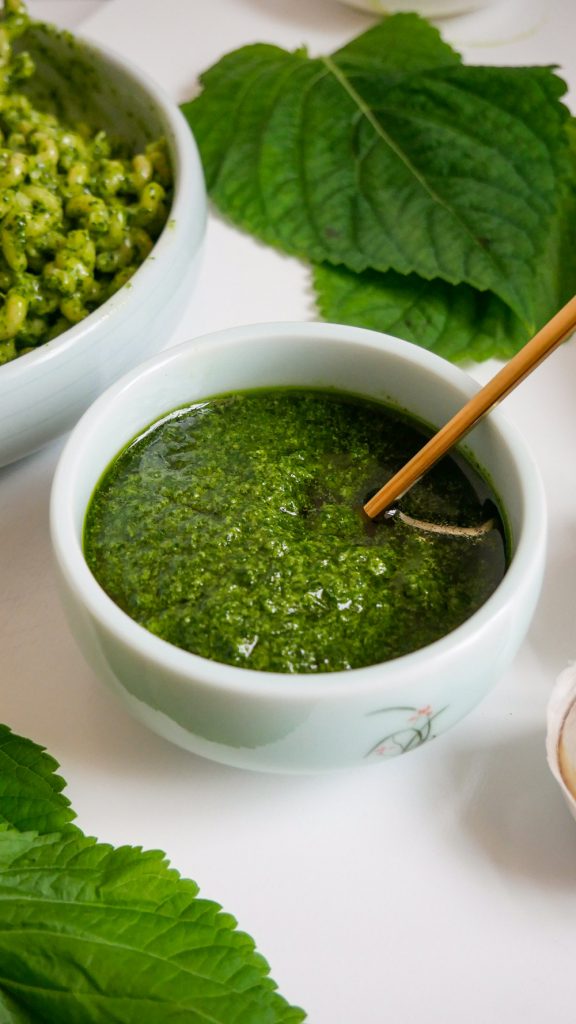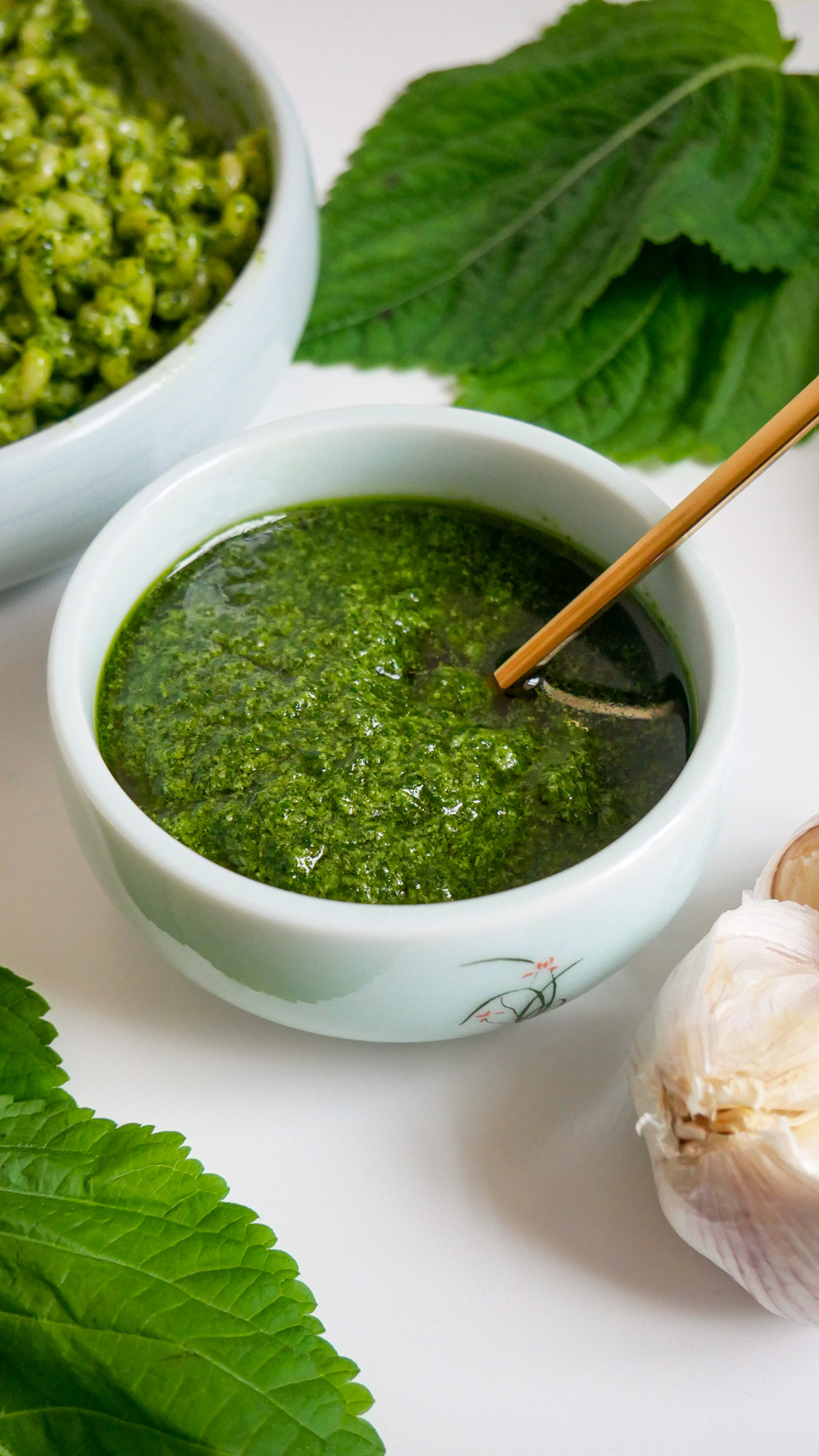By now you’re probably already familiar with perilla leaves but if you’re not, it’s an aromatic herb that’s commonly used in Korean cuisine. It’s a cross between mint, basil, anise, and cinnamon. It’s aggressively bold, herbaceous, and pungent – in all the right ways.
My parents used to have a huge perilla leaf garden and when you have an endless supply of an herb, you have to get creative. We started using perilla leaves in place of lettuce in our sandwiches, used them to garnish our stews, and even made pasta!
Instead of using basil for pesto, I’ve swapped it for perilla. You get the savory and nutty elements from the traditional pesto ingredients paired with the minty, slightly spicy, and sweet flavors from the perilla leaves. It’s a refreshing change from the classic basil pesto but this is not to say that it’s better than traditional pesto in any way.
If you’re bored of the regular basil pesto or you’re looking for ways to use up your perilla leaves, this recipe is for you! To have this sauce with pasta, check out my Perilla Pasta recipe!

Why you’ll love this recipe
With perilla leaves as the main character of the show, this pesto brings a unique twist to a traditional dish. This perilla pesto is not just a fusion take on an Italian classic, it’s a step into an unexplored yet mouthwatering terrain of Asian herbs. While this is great with pasta, it can also be slathered on a sandwich, used as a marinade for meats, or on top of homemade focaccia. It’s an extremely versatile condiment, and so good you might even eat it right out of the jar!
This recipe is very simple and straightforward to prepare. It comes together in about 15 minutes and can be made in advance for easy meals! This perilla pesto recipe is a must-try. Trust me, your palate will thank you!

Howto prepare Perilla Pesto
Step 1: Toast the pine nuts
Preheat the oven to 350F (175C).
Place the pine nuts on a sheet tray. Toast in the oven for 10 to 15 minutes, making sure to flip every 5 minutes.

Once the pine nuts are light brown in color, remove them from the oven and set aside to cool.
Step 2: Blanch the perilla leaves
In a pot with boiling water, blanch the perilla leaves for about 15 seconds.

Immediately transfer the perilla leaves into an ice bath. Once cooled, squeeze the perilla leaves to remove excess water.


Step 3: Make the pesto
In a food processor or blender, combine perilla leaves, toasted pine nuts. garlic cloves, parmesan cheese, olive oil, lemon juice, salt and pepper.


Blend until smooth. If the pesto is too thick, slowly drizzle in more extra virgin olive oil while blending until it reaches your desired consistency.


At this point, taste for seasoning and adjust if needed.
Step 4: Serve!
Serve with pasta, as a marinade for meat, with sandwiches or salads!


If not using right away, transfer to an air-tight glass container and drizzle extra virgin olive oil on top. This will prevent the pesto from oxidizing. Store in the fridge for up to 1 week.

Perilla Pesto Preparation Tips
To ensure your perilla pesto comes out delicious every time, here are a few tips to keep in mind:
- While I used a blender to make the pesto, preparing it in a mortar and pestle will actually result in a more flavorful pesto. This is ideal if you have the time and patience, but if you’re like me, a blender or food processor works just fine!
- The blanching of the perilla leaves and then plunging it into an ice bath will help preserve the green color and prevent it from oxidizing. Be sure not to blanch them for too long otherwise, it will cause the perilla to lose flavor. 15 seconds is all it needs!
- Don’t skip the step of toasting the pine nuts before adding them to the blender. Toasting the nuts gives them a deeper, nutter flavor which makes the pesto taste more complex and rich. Pine nuts have the tendency to burn very quickly so be sure to keep your eye on it! The pine nuts can also be toasted in a pan over the stove top.
- If you don’t have pine nuts, you can substitute them with cashew nuts, pistachios, almonds, sunflower seeds, or walnuts.
- Be sure to adjust the pesto ingredients based on your preferences. The quantities in this recipe are solely meant to be used as a guideline. Feel free to add more or less of the garlic, cheese, lime juice, and salt.
- If your pesto is too thick, slowly drizzle some olive oil while the blender is on until it reaches your desired consistency.
Perilla Pesto Ingredients & Substitutions

Perilla leaves: you can find perilla leaves at any Korean market. Choose the ones that are medium to large in size.
Pine nuts: pine nuts are essential for a pesto recipe. They must be toasted – don’t skip this step! Substitute pine nuts with cashews, pistachios, almonds, sunflower seeds, or walnuts.
Garlic: garlic is a classic pesto ingredient – feel free to add as much or as little as you like! I personally like my pesto garlicky so I use 3 to 4 cloves.
Parmesan cheese: I recommend using a block of parmesan cheese and grating it. The pre-grated cheese usually comes with additives so I always opt to grate it myself.
Extra virgin olive oil: using the highest quality olive oil is key! I personally like to use Spanish or Moroccan olive oil for this.
Lime juice: a touch of acidity will help balance out the savoriness and richness of the pesto. It also helps the pesto retain its vibrant green color. You can substitute lime juice with lemon juice.
Salt & Pepper: be sure to season and adjust as you go.
Frequently Asked Questions
Can I substitute perilla with other herbs for pesto?
Yes, absolutely! Pesto is extremely versatile and can be made with any combination of herbs. While basil is the traditional and most common herb used, you can also use cilantro, parsley, oregano, and more!
Can I make perilla pesto vegan?
Of course! The parmesan cheese can be substituted with nutritional yeast. It’s a great vegan alternative that provides a cheesy and funky flavor to the pesto.
How do I store perilla pesto?
The perilla pesto should be stored in a glass jar with an air-tight lid. It’ll stay good in the fridge for up to a week. Before storing it away, pour a thin layer of extra virgin olive oil on top before closing the jar. The olive oil acts as a barrier to prevent the pesto from being exposed to the air.
What can I use instead of pine nuts for pesto?
Pine nuts can be substituted for most nuts but the best substitute is cashews. You can also use other nuts including pistachios, almonds, sunflower seeds, and walnuts. Keep in mind that each nut brings a slightly different flavor so be sure to experiment and see which one you like the best.
Can I freeze the perilla pesto?
Yes! To freeze the perilla pesto, pour the pesto into an ice cube tray. Whenever you’re ready to use the pesto, just pop them out!
Looking for more easy and delicious fusion recipes?
1. Corn Cheese Balls – we’re switching up the popular Korean corn cheese appetizer and turning them into fried corn cheese balls! They’re incredibly crunchy, cheesy, and the ultimate snack!
2. Kimchi Alfredo Pasta – i’ve combined some of my favorite ingredients and flavors in this super decadent, creamy, and indulgent kimchi alfredo pasta! If you’re looking to jazz up pasta night, give this recipe a try!
3. Korean Fries – these Korean pickle brine fries are made with a popular Korean pickled radish brine which results in a sweet and salty flavor in every fry!
4. Mochi Pancakes – Mochi pancakes are light and fluffy while soft and chewy at the same time. They only take 20 minutes and if you love the texture of mochi, I promise you’ll love these pancakes!
5. Potato Cheese Donuts – these crispy potato cheese donuts are incredibly indulgent and delicious! After biting into the crispy panko breadcrumbs, you’re met with soft mashed potatoes followed by a sweet and tender onion ring and finally, an ooey gooey cheesy center.

Perilla Pesto
Ingredients
- 30 medium to large perilla leaves (about 45 g)
- 1/4 cup pine nuts
- 2-4 garlic cloves
- 1/2 cup freshly grated Parmesan-Reggiano cheese
- 1/4 cup extra virgin olive oil more if needed
- 1/2 tbsp lemon juice
- 1/2 tsp salt to taste
- 1/8 tsp freshly ground black pepper to taste
Instructions
- Preheat the oven to 350F (175C).
- Place the pine nuts on a sheet tray. Toast in the oven for 10 to 15 minutes, making sure to flip every 5 minutes. Once the pine nuts are light brown in color, remove them from the oven and set aside to cool.
- In a pot with boiling water, blanch the perilla leaves for about 15 seconds. Immediately transfer the perilla leaves into an ice bath. Once cooled, squeeze the perilla leaves to remove excess water.
- In a food processor or blender, combine perilla leaves, toasted pine nuts. garlic cloves, parmesan cheese, olive oil, lemon juice, salt and pepper. Blend until smooth.
- If the pesto is too thick, slowly drizzle in more extra virgin olive oil while blending until it reaches your desired consistency. At this point, taste for seasoning and adjust if needed.
- If not using right away, transfer to an air-tight glass container and drizzle extra virgin olive oil on top. This will prevent the pesto from oxidizing. Store in the fridge for up to 1 week.